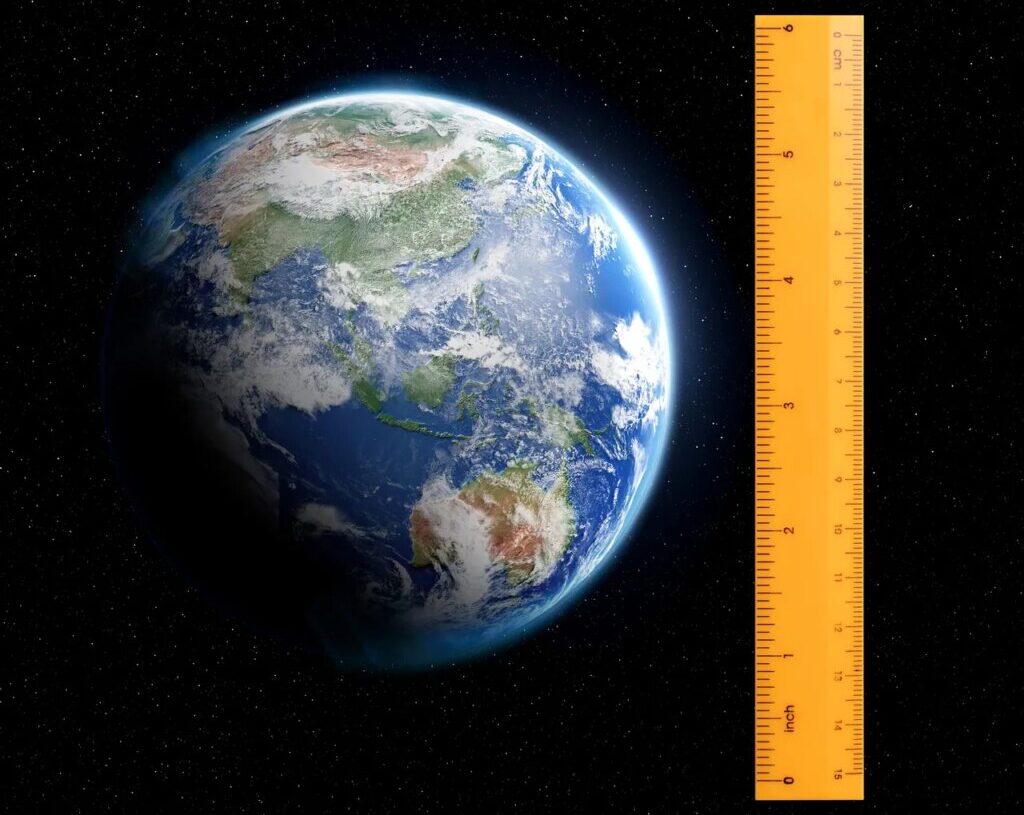More than 2,000 years ago, pretty much every educated human knew the Earth was round. There are some pretty obvious clues, after all. If you travel south, you see stars and constellations you’ve never seen before (because they’re blocked by Earth’s curvature). When a ship comes into port, you see the top of it before the bottom (because the ocean surface is curved). Finally, when Earth’s shadow falls on the moon in a lunar eclipse, the shadow is a circle. I mean, c’mon!
But this is impressive: Around 240 BC, the Greek mathematician Eratosthenes, head of the famous Library of Alexandria in Egypt, came up with a brilliant way to calculate the radius of the spherical Earth. You can do it too, and it doesn’t require any fancy equipment. I’m going to show you how to measure the Earth’s size using Lego pieces.
Of course, Eratosthenes didn’t have Legos. But he knew that at noon on the summer solstice, the sun shone straight down a vertical well in Syene, Egypt. This meant the sun was directly overhead. So what did he do? He stuck a pole in the ground in Alexandria, and at noon on the same day he found that it cast a shadow, meaning the sun wasn’t overhead there.
In the picture below, I’ve used a pole in Syene (not to scale, obviously) instead of a well, but it’s the same idea. You can see that if the sun is in line with the Syene pole, it won’t be in line with the Alexandria pole. This could only mean the Earth is curved. But, yeah, he knew that.
Now to find the size of the Earth, he needed just two numbers, the angle of the shadow in Alexandria and the distance between the two cities. He found the shadow angle to be 7.2 degrees from the vertical—but to be general, let’s call this theta (θ). Using basic geometry, this meant the two cities were θ degrees apart on Earth’s 360-degree circumference.
At this point, all he needed was the distance between the two cities—the arc length—which I’ll call s. Maybe he hired someone to pace it off, but in any case he got a distance of 5,000 stadia—about 800 kilometers. He plugged those two numbers into the equation above and cranked out a value for R, the radius of our planet. Turns out he was off by less than 1 percent!
Do It Yourself
You can do this yourself, anyplace in the world. All you need are three things that pretty much everyone has—a friend, a phone, and some Lego blocks. Here’s how it works: You and your pal build identical Lego structures, and you drive one of them a certain distance away.
Now you both measure your shadow angle at the same moment and calculate the difference. (That’s what Eratosthenes did—it’s just that at Syene he had an angle of 0 degrees, so the difference was the same as the angle in Alexandria.) Finally, get the straight-line distance between the two locations and do five seconds of math. Boom!
Why Legos pieces? Actually, they’re pretty handy for physics experiments, in part because they’re very uniform. If I build something with Lego and you build the same thing, they’re going to be the same size.
How about a quick measurement? Let’s take a bunch of blocks and stack them together. Here’s what that looks like.
I measured the position of the end of each block and plotted position versus block number.
You can see that over these 12 blocks, the relationship between length and number of blocks is linear. Fitting a linear function, I get a slope of 0.9629 centimeters per block. What this means is that if I stack up 10 blocks, I know the height will be 9.6 cm. OK, here’s my no-tech Lego device:
You can see there’s a base with a stack of 9 blocks. The pole on top is another 4 blocks tall. This gives a total height of 13 blocks (12.48 centimeters). The base has to be level, so I added a Lego plumb bob with a Lego dot underneath. (This iteration wasn’t perfect, but I fixed it.) Now, when I put it out in the sunlight it looks like this:
Orient the device so the shadow falls in line with the Lego dots. The dot-to-dot distance is 0.8 cm, so we can count the dot-length of the shadow. In the image above, its slightly less than 16 dots long. But the starting point is halfway between two dots, so we need to add an extra half dot. Overall, I measured this shadow as 16.3 dots, or 13.04 cm.
Now I’ll show you how to get the shadow angle very precisely without using any kind of angle-measuring device. Using trigonometry, we can just calculate the shadow angle (θ) using the height (h) of the device and the length (L) of the shadow:
In this case, I get a shadow angle of 43.7 degrees. I used the height and length in centimeters above, but to be pure about it, we could measure in Lego dots. (Any units will work, since they cancel in the numerator and denominator.) My device is 15.6 dots high, so in general, if I count the number of Lego dots (nd) for shadow length, the angle is:
Measuring the Size of the Earth
OK, you’re ready to go! You have two identical shadow devices. Give one to your friend, who will drive some distance (s) away—the farther, the better, but at least 100 kilometers. You can get the straight-line distance in Google Maps, but in the DIY spirit of this thing, try to just find a straight section of highway and use your car’s odometer.
So your friend is a distance s away. Now, coordinating by phone, you both line up the shadow on your Lego devices and take a photo at the same time. Here’s the equation to calculate the radius once you get the two angles (θ1 and θ2).
Make sure your angles are in units of radians (not degrees), where 2π radians = 360 degrees. But after that you will get the value of R (the radius of Earth) in the same units that you measured the distance traveled (s). If you get something close to 6.3 x 106 meters, then you did something kind of magic. You measured the Earth with Lego blocks.
The post How to Measure the Earth’s Radius With Legos appeared first on Wired.




